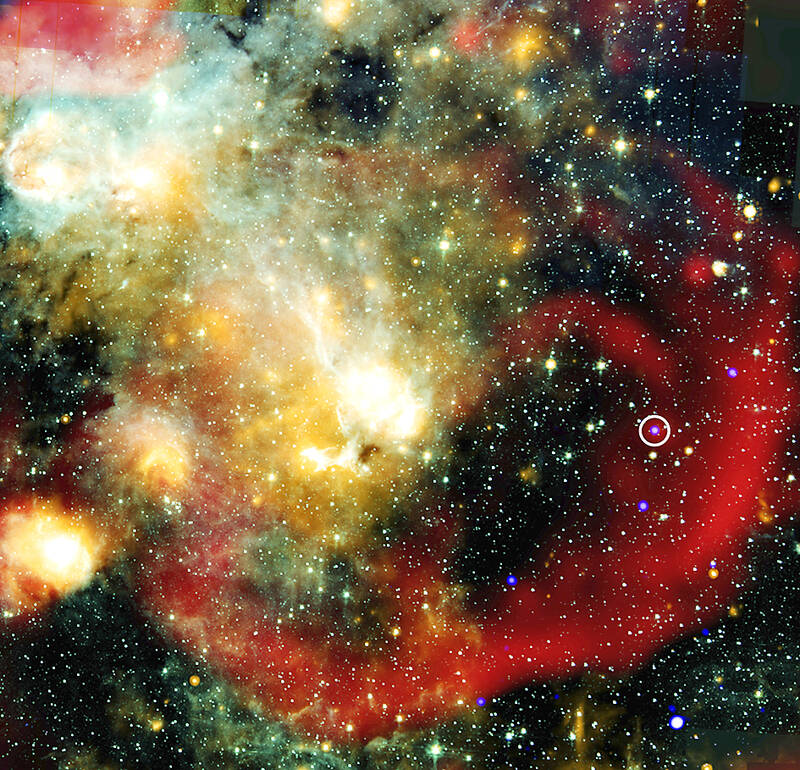Astronomers have spotted a star acting unlike any other ever observed, that is unleashing a curious combination of radio waves and X-rays every 44 minutes, pegging it as an exotic member of a class of celestial objects first identified only three years ago. It is located in the Milky Way galaxy about 15,000 light-years from Earth in the direction of the constellation Scutum.
The researchers said it belongs to a class of objects called “long-period radio transients,” known for bright bursts of radio waves that appear every few minutes to several hours.
“What these objects are and how they generate their unusual signals remain a mystery,” said Curtin University astronomer Ziteng Wang, lead author of the study published this week in the journal Nature.

Photo: NASA/Chandra/Spitzer/MeerKat via AP
In the new study, the researchers used data from NASA’s orbiting Chandra X-ray Observatory, the Australian Square Kilometre Array Pathfinder telescope in Australia and other telescopes.
While the emission of radio waves from the object is similar to the approximately 10 other known examples of this class, it is the only one sending out X-rays, said astrophysicist and study coauthor Nanda Rea of the Institute of Space Sciences in Barcelona.
The researchers have some hypotheses about the nature of this star, including that it might be a magnetar — a spinning neutron star with an extreme magnetic field — or a white dwarf, a highly compact stellar ember, with a close and quick orbit around a small companion star.
“However, neither of them could explain all observational features we saw,” Wang said.
Stars with up to eight times the mass of our sun appear destined to end up as a white dwarf. They eventually burn up all the hydrogen they use as fuel. Gravity then causes them to collapse and blow off their outer layers, eventually leaving behind a compact core roughly the diameter of Earth — the white dwarf.
The observed radio waves could have been generated by the interaction between the white dwarf and the hypothesized companion star, the researchers said.
“The radio brightness of the object varies a lot. We saw no radio emission from the object before November 2023. And in February 2024, we saw it became extremely bright. Fewer than 30 objects in the sky have ever reached such brightness in radio waves. Remarkably, at the same time, we also detected X-ray pulses from the object. We can still detect it in radio, but much fainter,” Wang said.
Wang said it is thrilling to see a new type of behavior for stars.

The death of a former head of China’s one-child policy has been met not by tributes, but by castigation of the abandoned policy on social media this week. State media praised Peng Peiyun (彭珮雲), former head of China’s National Family Planning Commission from 1988 to 1998, as “an outstanding leader” in her work related to women and children. The reaction on Chinese social media to Peng’s death in Beijing on Sunday, just shy of her 96th birthday, was less positive. “Those children who were lost, naked, are waiting for you over there” in the afterlife, one person posted on China’s Sina Weibo platform. China’s

‘NO COUNTRY BUMPKIN’: The judge rejected arguments that former prime minister Najib Razak was an unwitting victim, saying Najib took steps to protect his position Imprisoned former Malaysian prime minister Najib Razak was yesterday convicted, following a corruption trial tied to multibillion-dollar looting of the 1Malaysia Development Berhad (1MDB) state investment fund. The nation’s high court found Najib, 72, guilty on four counts of abuse of power and 21 charges of money laundering related to more than US$700 million channeled into his personal bank accounts from the 1MDB fund. Najib denied any wrongdoing, and maintained the funds were a political donation from Saudi Arabia and that he had been misled by rogue financiers led by businessman Low Taek Jho. Low, thought to be the scandal’s mastermind, remains

Australian Prime Minister Anthony Albanese yesterday announced plans for a national bravery award to recognize civilians and first responders who confronted “the worst of evil” during an anti-Semitic terror attack that left 15 dead and has cast a heavy shadow over the nation’s holiday season. Albanese said he plans to establish a special honors system for those who placed themselves in harm’s way to help during the attack on a beachside Hanukkah celebration, like Ahmed al-Ahmed, a Syrian-Australian Muslim who disarmed one of the assailants before being wounded himself. Sajid Akram, who was killed by police during the Dec. 14 attack, and

VISHNU VANDALS: A Cambodian official accused Thailand of destroying a statue in a disputed border area, with video showing the Hindu structure being torn down The Thai military said ceasefire talks with Cambodia, set to begin yesterday, are expected to conclude with a meeting of the countries’ defense ministers on Saturday, as the two sides seek to end weeks of deadly clashes. The talks started at 4pm in Thailand’s Chanthaburi Province, which borders Cambodia. The Thai Ministry of Defense outlined several demands to be discussed ahead of the bilateral meeting of the General Border Committee (GBC) on Saturday. If secretariat-level discussions fail to reach agreement on key technical frameworks such as troop deployments, the Thai side would not proceed with the GBC meeting or sign any agreement on